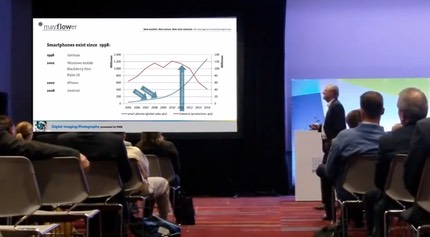(commentary)
Last week’s article on the panic starting to form in the offices of the Japanese camera companies certainly sparked a lot of discussion across the net and via my In Box. The comments that caused me to grin, though, were the ones that accused me of being an optimist. The folks calling me an optimist insist that camera sales will continue to slide downwards forever.

from Merriam-Webster
Those that know me well will say I’m mostly a curmudgeon. While definitions of that word generally don’t directly indicate whether such folks are optimists or pessimists, if you’re “annoyed and complain” generally I’d say that’s a good sign of pessimism ;~).
Funny thing is, I’m not at all pessimistic about the future of cameras. I am pessimistic about the future of the companies making cameras if they continue their current course. Interestingly enough, I find what I’m saying and writing today is actually a very close mirror to what I was saying and writing in the 1990’s about cameras, and SLRs in particular. In essence: great products, but why do I need a new one?
Two types of consumer products exist. Some you need to live a modern life, such as a phone, or a car in Los Angeles. Others are completely discretionary, such as cameras. It’s especially true of discretionary devices that you need to reinvent them from time to time, or else you get some sort of declining sales from them eventually.
Back in the 90’s, film SLRs were in decline. Most households that wanted a high quality camera had bought one. They didn’t need two. The primary drivers of sales in the 90’s were new families (in particular birth of first child was an SLR sales driver) and replacements (dropped, lost, stopped working, perhaps user finally decided a new feature(s) was worth the change). The SLR market became a flat-to-declining one dominated by Canon and Nikon, typically around 4m units a year.
DSLRs re-energized the market. Digital cameras in general solved one huge hassle for film camera users: the delay between taking a photo and seeing the results. That delay had a lot of sub-factors to it: it inhibited learning (no quick feedback when you changed something), it typically required driving somewhere to get the film dealt with (sometimes twice), and you had to keep track of something during the delay between shooting and seeing prints (the film cartridge itself; don’t laugh, I once left one film cartridge on the seat of a rental car on a magazine assignment once).
Those problems went away with digital cameras (though some new ones were introduced). Still, it didn’t take long before most of the folk with SLRs in their closet suddenly wanted DSLRs because they got rid of the hassles that had banished the cameras to the closet. Moreover, the sales peak of DSLRs was higher than SLRs. Why? Because DSLRs are just more fun than SLRs, basically. Being able to see what you’re doing in real time let you experiment, play, try new things. Photography became engaging again. Heck, and darkrooms suddenly appeared on your desktop and could travel with you. What’s more fun that than? (Disclosure: real darkrooms were a great make-out location in college, and that was fun that Photoshop can’t replicate ;~).
So why am I being called an optimist? Because I believe that we can reinvigorate camera sales by producing another change to cameras that solves huge user hassles (this time hassles for digital camera users). By making cameras that deal with customers’ biggest problems, we once again would open the floodgates to dumping old for new, as we did with the SLR->DSLR transition. I’m not alone in this assertion, by the way (see this presentation by Heino Hilbig at this year’s PMA conference).
Do I believe that we’d get back to the same peak level of sales DSLRs hit if the camera companies made this transition to a newer, friendlier camera correctly? Probably not. But one thing that would be solved is the biggest thing that’s decimating camera sales right now: lack of new buyers. Simply put, the smartphone is good enough for most imaging purposes if the hassle level of doing any better is too high. The generation that’s growing up with smartphones as cameras doesn’t like the huge inconvenience leap that’s necessary to take their imaging to another level. But if you take out that hassle and make the next generation of digital cameras more accessible and sharing—and yes, fun—then we just might get new buyers coming back into the market.
The alternative, as I’ve noted, is that we just continue in the slow death spiral. Literally. Because so many of the film SLR users who moved to DSLRs are aging or now retired, the replacement market literally dies off if you can’t attract new users.
So am I an optimist? Yes. I have a strong belief that if you understand the problem, you can solve it. What I’m not seeing at the moment is that the camera companies are designing new products to solve the real problem, which means that they don’t really understand it.






